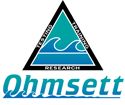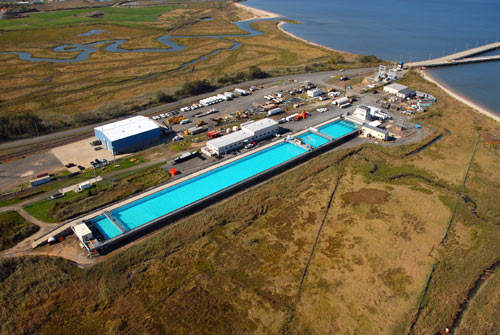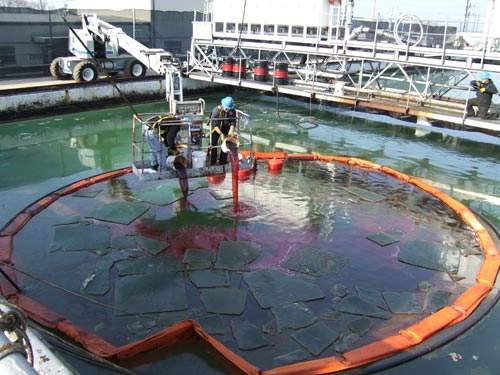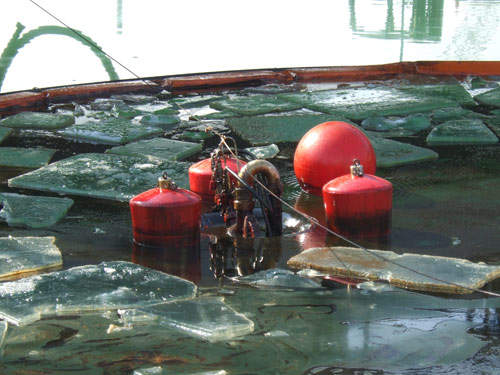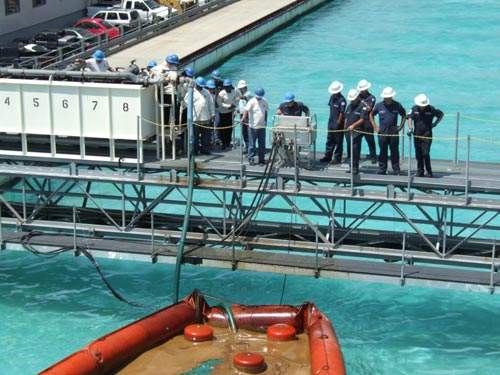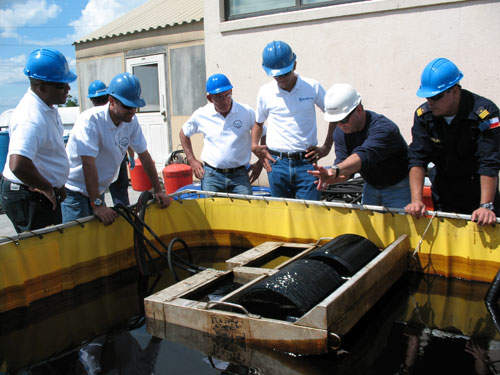Ohmsett, the National Oil Spill Response Research and Renewable Energy Test Facility, is the only facility where full-scale oil spill response equipment testing, training and research can be conducted in a marine environment with real oil under controlled environmental conditions, including waves, temperature and oil types.
Oil spill response equipment and technology
Ohmsett’s mission is to increase oil spill response capability through independent and objective performance testing of equipment, providing realistic training to response personnel, and improving technologies through research and development. Public and private sector entities use Ohmsett as a research center to test oil spill containment / clean-up equipment and techniques, test new designs in response equipment, and conduct training with actual oil spill response technologies.
The primary feature of Ohmsett is a large, above ground, concrete wave test tank measuring 667ft long, 65ft wide and 11ft deep. The tank is filled to a depth of 8ft with 2.6 million gallons of crystal clear salt water. The facility is located on Naval Weapons Station Earle in Leonardo, New Jersey, one hour south of New York City, and is maintained and operated by the Department of Interior Minerals Management Service (MMS) through a contract with MAR, Rockville, Maryland.
Oil spill response equipment testing and product research
The Ohmsett facility represents a necessary intermediate step between small-scale laboratory testing and open water testing of equipment. Ohmsett is used for examining the fate and behavior of crude oil and oil product research, and testing and evaluating oil spill skimmers and fire-resistant containment booms.
These services are offered through the use of an air-injected propane burner system that realistically simulates in-situ burning at sea, remote sensing equipment and systems to detect oil, sorbents and sorbent booms, and cold water testing and training (with or without ice) with the ability to simulate realistic broken ice conditions.
Realistic dispersant effectiveness testing
The Ohmsett facility has become a world leader in realistic dispersant effectiveness testing through the design and development of a calibrated, referenced and realistic test protocol and subsequent testing under cold and temperate conditions using fresh and weathered crude and fuel oils.
The National Research Council strongly supports the use of wave tank testing in its recent review of chemical dispersants. Ohmsett is the world’s largest wave-tank complex presently conducting such research and is the logical venue for bridging the gap between laboratory and field testing.
Hands-on oil spill response training
Ohmsett is the premier hands-on training site for state and federal government agencies, private industry and foreign countries. Ohmsett has been selected by the US Coast Guard (USCG) as its designated training facility for personnel newly assigned to oil spill response duties and for personnel attached to the National Strike Force Coordination Center. Other government agencies such as the US Environmental Protection Agency and the US Navy use the facility to train their emergency response personnel.
Many domestic and international oil companies and private spill response organizations send their personnel to Ohmsett training classes to practice with the same equipment they have in their inventory. This allows students the opportunity of containing and collecting different types of oils during changing sea conditions from calm to open ocean.
Oil spill response and strategies training courses
Ohmsett’s oil spill response and strategies training covers the National Incident Management System (NIMS) IS-700 series, incident command systems (ICS) IS-100 series sanctioned by FEMA, geographic information systems (GIS) applications in spill response, and an eight-hour HAZWOPER refresher.
Training advantages include increased proficiency with hands-on training in the tank where students practice recovering real oil, using full-scale equipment under realistic oil spill conditions with waves and currents, and performance analysis of collected and measured recovered oil. Training sessions can be configured to meet specific needs.

